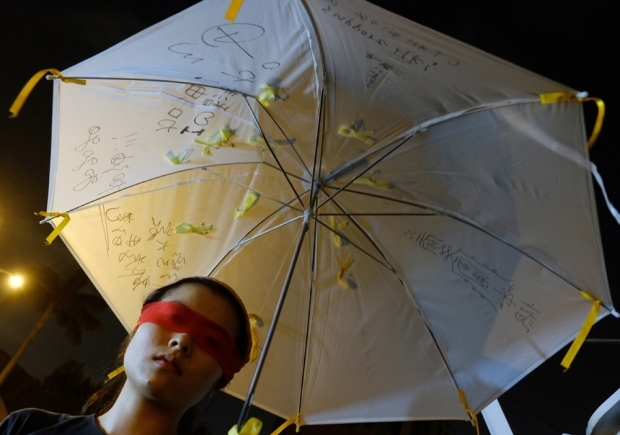The second and third days of mass protests to demand broader democracy in Hong Kong ended with none of the violence and confrontation seen on September 28. Thousands of protesters continued to gather on the streets of the city’s busiest shopping and financial districts, sitting around, chanting, and singing in a "festive mood" or braving sudden thunderstorms with makeshift tents and flimsy umbrellas. The police had largely retreated and riot gear was nowhere to be seen. The only notable police action was the presence of a few police negotiators who tried halfheartedly to persuade protesters to leave, to no avail.
But the war for Hong Kong hearts and minds, as well as the global audience, is only heating up after September 28, when peaceful, student-led pro-democracy protesters pushing for universal suffrage were greeted by tear gas and pepper spray deployed by Hong Kong police. Western readers have mostly received a straightforward narrative about a people united in their aspirations for true democracy, but local media coverage of the events reflects a more complex reality on the ground.
A scan of the territory’s top newspapers on September 30 shows worries about the movement’s short- to medium-term effects on local businesses, tourism, and the stock market. Only Apple Daily, the newspaper owned by Jimmy Lai, a media tycoon well known for his anti-communist stance, was unabashedly supportive of the protests with the triumphant headline “Democracy Occupies Hong Kong.” The paper made no mention of any disruptions to the city’s transportation, business life, or drops in the stock market index in its 20-page coverage of the protests.
Other papers, however, are somewhat less sanguine. While much of its coverage focused on the defiance of the protesters and the police retreat, the South China Morning Post, Hong Kong’s standard-bearing English newspaper, warned that volatility spiked in the market due to the political unrest and covered the early closure of shops in the affected areas. An editorial in Ming Pao, a relatively neutral Chinese-language newspaper, urged protesters and the government to find a way to compromise. A headline in the Hong Kong Economic Journal, a financial daily, worried that the occupation would “have no end.”
The pro-Beijing newspapers, however, painted a much darker view of the protests. The Sing Tao Daily, putting the word “danger” in the largest font, led with a story that implied that local triads had infiltrated the protesting crowd in Mongkok, a large shopping district. The front page of Ta Kung Pao, a Hong Kong newspaper with direct ties to the mainland Chinese government, warned that the movement is a “disaster for all of Hong Kong” and covered the story of an elderly woman who supposedly could not see a sickly relative in her last moments because of traffic disruptions caused by the movement. The September 30 editions of many of the pro-Beijing newspapers featured prominent advertisements placed by mainland-affiliated groups or business associations that condemned the movement as “illegal.”
Hong Kong’s crowded media landscape is famously rancorous, and many of the local newspapers exhibit clear editorial biases. In 2012, iSun Affairs, a now-defunct Hong Kong news magazine, produced an infographic that mapped Hong Kong’s main newspapers along an X-axis of “Pro-Beijing” versus “Pro-Democracy” and a Y-axis of “Pro-Masses” versus “Pro-Business.” By iSun Affairs’ count, seven out of 16 newspapers tallied were in the pro-Beijing and pro-business quadrant.
Hong Kong media, of course, is no longer dominated by the print press. Internet-based media outlets, like Passion Times, InMediaHK, and VJ Media, not to mention countless Facebook groups, cater to a younger generation more used to tapping on a smartphone than soiling their hands with ink. Rumors, news, and views are often shared among friends and family on WhatsApp, the most popular messaging app in Hong Kong. The social media-savvy protesters and student organizers have created viral memes, pleaded for volunteers, and donated supplies over Internet social networks.
In the universe of Facebook and WhatsApp, worries about the movement’s effect on the economy, housing prices, or the stock market seem almost quaint, while calls persist for “victory”—that is, the full satisfaction of protester demands for withdrawal of the electoral framework handed down by the Beijing government and resignation of the territory’s chief executive Leung Chun-ying, the head of the Hong Kong government who is perceived to be cozy with Beijing.
But as Leung reiterated on September 30, Beijing will not back down in the face of the protests. The movement does not seem to have a clear organization or leadership that could represent the protesters to negotiate with the government. While Leung has made clear that the Chinese military would not get involved, it is also unclear how the protesters might be persuaded to leave the streets without the victory they seek.




